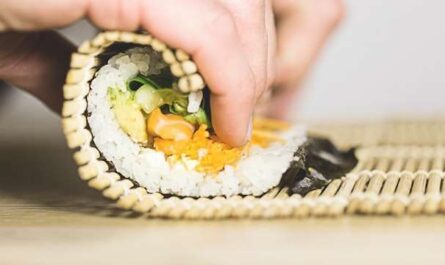For enthusiasts of Japanese cuisine, particularly sushi, understanding what a hangiri bowl is can enhance your culinary journey. This essential piece of kitchen equipment plays a critical role in crafting perfect sushi rice, which is the foundation of great sushi. In this article, we’ll unveil the significance of the hangiri bowl and how it contributes to the delectable world of sushi making.
The hangiri bowl, also known as handai, is a traditional wooden vessel, typically made of cypress wood and bound with copper bands. It is primarily used for cooling and seasoning sushi rice. Let’s delve deeper into its fascinating history and purpose within Japanese kitchens.

An Introduction to Hangiri Bowl
The hangiri bowl is an indispensable tool in the realm of sushi making. Its origins can be traced back to ancient Japan, where it was crafted to aid in the delicate process of handling rice. The bowl’s flat, wide design allows for quick cooling of rice, which is a crucial step in preparing it for sushi.
The Purpose of a Hangiri Bowl
One might wonder, why is this specific bowl necessary? The answer lies in its unique attributes. The wooden nature of the bowl helps absorb excess moisture from the rice, while its large surface area fosters rapid cooling. This process is vital to achieving the right texture and flavor in sushi rice.
By utilizing a hangiri bowl, chefs can ensure that the rice cools evenly and is seasoned to perfection. To learn more about the process of cooling sushi rice effectively, visit this page.
Choosing the Right Hangiri Bowl
When selecting a hangiri bowl, size and material are crucial factors. Typically, these bowls range from 10 to 30 inches in diameter. For home cooks, a smaller bowl around 10 to 12 inches is adequate. Ensure that the wood quality is high to maximize its moisture-absorbing properties.
For more insights on maintaining kitchen tools, check out this article on bamboo mats maintenance.
How to Use a Hangiri Bowl
The use of a hangiri bowl is a straightforward process, yet it requires a gentle technique. Post-cooking, the rice is transferred into the bowl for seasoning with vinegar. It must be carefully mixed with a wooden paddle, which prevents crushing the grains and allows each grain to be coated evenly. This ensures a glossy, non-sticky rice texture, ideal for sushi.
Maintaining Your Hangiri Bowl
Proper maintenance of your hangiri bowl will prolong its life and keep it functioning well. After each use, rinse the bowl with warm water and allow it to air dry. Avoid using soap, as it might interfere with the woods natural properties.
For additional storage solutions for sushi-related equipment, explore this guide.
Cultural Significance of the Hangiri Bowl
The hangiri bowl is more than just a kitchen tool; it represents a rich cultural heritage. Its continued use in modern cooking signifies respect for traditional methods that have been passed down through generations. This illustrates the Japanese dedication to crafting each sushi element with precision.
The Role of Hangiri Bowl in Sushi Recipes
In the process of making sushi, whether it is nigiri, maki, or temaki, the texture of the rice is of utmost importance. The hangiri bowl ensures that sushi rice attains its characteristic sticky yet separated consistency. Without it, the rice may cool unevenly, leading to subpar sushi creation.
For innovative ways to enhance your sushi experience, consider learning about using molds for making onigiri.
Hangiri Bowl vs. Other Kitchen Tools
While some might substitute mixing bowls for a hangiri bowl, the results are not the same. The specialized design and material of the hangiri are specifically tailored for the requirements of sushi rice preparation. Using alternatives often leads to a compromised flavor and texture.
Please See Sushi Etiquette Tips
Understanding the proper use of a hangiri bowl ties into greater sushi etiquette, which involves various customs and practices when preparing and consuming sushi. More insights are shared in these sushi etiquette tips. Adhering to these traditions not only enhances the overall dining experience but also shows appreciation for Japanese culture.
Frequently Asked Questions
Why is a hangiri bowl made of wood?
The wood of a hangiri bowl helps absorb excess moisture from the rice, promoting a perfect texture and flavor for sushi rice.
Can I use a metal bowl instead of a hangiri bowl?
While possible, metal bowls do not provide the same moisture-absorbing benefits as a wooden hangiri bowl, impacting the quality of your sushi rice.
How should I store my hangiri bowl?
It’s best to store your hangiri bowl in a dry place. Proper cleaning and air drying after each use will keep it in excellent condition.

Conclusion
Understanding what a hangiri bowl is, adds a new dimension to your sushi-making skills. This simple yet effective tool highlights the importance of tradition and technique in Japanese cuisine. Whether you’re a sushi novice or a seasoned enthusiast, the hangiri bowl is a worthy addition to your culinary collection.
This article contains affiliate links. We may earn a commission at no extra cost to you.


